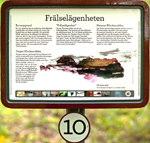Nature and Culture Trail Klockarudden
2. The Landscape of the Archipelago
Nature in the archipelago has evolved
over a period of 2 billion years. What we call the bedrock is
the remains of an enormous mountain range which once stretched
over the entire archipelago. This has been worn down over
millions of years and only the bedrock survives. During the
process of erosion, cracks and valleys have been created in the
bedrock which now form waterways, while other parts have risen
and formed islands.
About 15,000 years ago Sweden was covered by ice. The movement of the ice has crushed the bedrock and carried loose material from the peaks to the lower levels. Slabs of rock have been polished round and smooth where the ice has carried gravel in front of it, creating deposits of stone, gravel and sand.About 10,000 years ago the ice started melting and the land masses which had been weighed down by the ice began to rise. This process, known as “post-glacial rebound”, continues to this day in the Stockholm archipelago at a rate of about 4 mm every year. This area is an example of a landscape characterized by post-glacial rebound. At the top is the ancient bedrock with its sparse pine-woods. The next zone is full of boulders with a shallow layer of earth covered with pine and bilberry. The rocks become smaller and smaller the further down we go until finally, at the bottom, we find gravel and sandy soil.Deciduous trees and herbs thrive in the richer soil here. By the water’s edge the sand turns to clay and we find reeds growing.As time goes by people have to adapt to the consequences of post-glacial rebound. Jetties and boathouses have to be moved for them to be useable, and property boundaries have to be adjusted.A well-known reef which has become a fully visible islet is “Franska stenarna” near Djurö. A heavily laden man-of-war went aground here in the autumn of 1525. This was one of Gustav Vasa’s ships on its way to Djurhamn. The hull was holed in the collision and the ship filled with water and sank. It ended up on a ledge 35 metres below the surface. A lighthouse was built on what had by then become an islet. No one knew that the wreck of a ship which had belonged to Gustav Vasa was down below until 1990 when it was discovered and scientifically examined.To get to stop number 3 continue down the hill and turn left past the Boat House restaurant.
|












